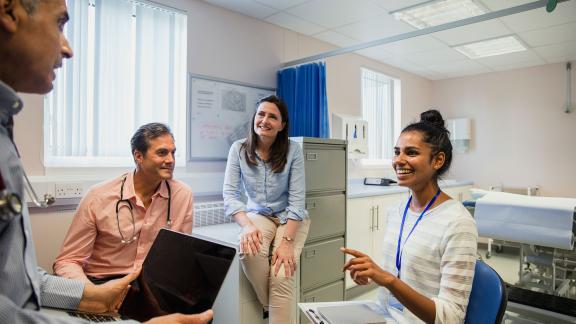Equitable care leads to improved health outcomes for people with learning disabilities

The West Yorkshire Health and Care Partnership is supporting its learning disability population and families by harnessing the scope of the NHS’s Transforming Care Programme (TCP) to ensure early intervention support is readily available to these individuals and their families, through partnership working.
Although the focus in this case study is on the Building the Right Support pilot project, other existing learning disability programmes that have demonstrated positive results are also referenced.
Key benefits and outcomes
- Partnership working through the care (education) and treatment reviews (CeTR) means that fewer young people with learning disabilities (with or without autism) are being admitted into assessment and treatment hospitals.
- Additional reduction in day appointments not being attended (DNA).
- On track to meet NHSEI’s target of 75 per cent of the learning disability population undergoing their annual health checks by March 2022.
What the organisation faced
People with learning disabilities face a range of difficulties, with a life expectancy up to 20 years lower than the rest of the population.
Although the challenges faced are not unique, the West Yorkshire Health and Care Partnership recognised that its health inequalities are more stark across all areas of population health compared to other areas of the country. For people with learning disabilities and autism especially, these inequalities start early in life and stem from barriers in accessing appropriate and effective healthcare and are therefore, to an extent, avoidable. Contributing factors include poor access to annual physical health checks, long hospital waiting times, and lack of understanding and expertise within wider mental health provision.
The partnership wanted to establish a non-clinical model that supports and challenges the way the current health and care system offers support to children, young people and their families at times of crisis, by providing better, holistic support – involving partners - in or near their family home and in their communities.
The West Yorkshire Transforming Care Programme (TCP), on behalf of the Health and Care Partnership, decided that the best way to provide this support was via the national TCP. The TCP delivers on the national plan, Building the Right Support, which gives commissioners a framework to develop more community services for people with learning disabilities and/or autism, to prevent hospitalisation.
The national TCP recently broadened its original remit to be an all-aged programme, that includes autistic people who do not have a learning disability.
What the organisation did
As part of delivering on Building the Right Support for children, young people and adults with learning disabilities and meeting the NHS’s Long Term Plan, West Yorkshire Transforming Care Programme, on behalf of the Health and Care Partnership, successfully applied to be one of 13 national pilot sites, to lead on developing and embedding the key worker function for children and young people with a learning disability, or with autism.
The TCP approach to delivering this differs from other pilot sites in that the partnership wanted the scheme to have the voluntary, community and social enterprise (VCSE) sector viewed as the lead delivery provider of this service, working in partnership with people with lived experience. The charity Barnardo’s now leads this work on behalf of the partnership and is using its national VCSE presence and cross-agency networking skills to strengthen their position locally and question and challenge the current pathways and systems approaches.
Each child at risk of going into hospital or in a secure hospital needs to be supported around the system they find themselves in. Barnardo’s key workers use the tools available from the TCP to provide early identification of the children, young people and their families at risk of going into crisis. These tools are:
- Dynamic support register (DSR) - this is a fluid document and register of individuals who might be on the cusp of their needs escalating, to ensure they are identified quickly and given support.
- Care (education) and treatment reviews (CeTR) - these identify the multi-disciplinary support required for an individual and/or their family to support them to be safe and well within the family home or school. It’s a review that happens with the key individuals involved in that person’s life and may require the input of teams and partners across education, housing and social services, as well as health.
The key worker’s role entails ensuring actions are recordable and being acted on/ followed through from the eyes of the individual and their family. The process may require getting the professionals/ social care teams to think differently. For example, a clinician may see the behaviour of an individual or child with a learning disability and/ or autism at risk of hospital admission as merely difficult, or complex. The role of the key worker is to challenge that clinician. They also understand the legalities behind the discharge and the need for a planned discharge for those individuals already admitted.
Even if a person still needs to be admitted to hospital, they must have a CeTR within 28 days of admission, which assesses the support required on discharge. This, alongside an agreed discharge date, means there are no longer any stays of an undetermined timeline.
Other West Yorkshire Health and Care Partnership priorities include an analysis of the housing needs for people with a learning disability, as well as supporting them into employment.
Results and benefits
Although the partnership’s monitoring of progress and outcomes is on an ongoing basis, there are a number of significant improvements so far.
The CeTR has been very effective at reducing hospital admissions and preventing young people from going into a CAHMS tier 4 process. Currently only four children and young people in the whole area with learning disabilities (with or without autism), are in a tier 4 CAMHS hospital.
The multi-disciplinary approach of the dynamic support register has also been very effective, with a variety of partners involved in the risk identification process (such as the ambulance service, the police, or other agencies) to ensure the tools and resources are in place early to try to prevent hospital admission. The key worker supports the voice of the child and young person and their families to ensure actions are delivered with the identified timescales.
Families have also played a vital role in developing, sourcing and delivering training and awareness-raising, to ensure all services can better support people with learning disabilities.
Additionally, the partnership is rapidly building a bank of trusted and robust data relating to people with learning disabilities, from all service areas, within the health and care system, which will ensure future improvements are acted on rapidly. For example, the involvement of housing teams have provided an increased offer to individual tenancies both within shared and single occupancy properties. This move towards independent living is beneficial to both the individuals with learning disabilities and their families.
Additionally, with their quota already at 73 per cent, the West Yorkshire Health and Care Partnership is on track to meet the target set by NHS England and NHS Improvement for 75 per cent of the learning disability population to have undergone their annual health check by March 2022.
Overcoming obstacles
The reason West Yorkshire Health and Care Partnership wanted the pilot scheme to sit in the voluntary sector is to avoid having a ‘same mindset’ approach. It is a challenge to think differently and each person’s journey is different. Recognising that it might be an easy flow for some, but others might require a lot of work to change pre-conceived ideas (and the results may not be seen immediately) remains a challenge. However an agreement to change is the vital first step.
This is why choosing a completely different organisation with experience of working with children and young people, but one not aligned to anything specific within the health sector, was important to both challenge the usual processes and avoid replicating anything done before.
Takeaway tips
- Recognise the value of what other organisations can bring to the table. The professionals don’t always know the right thing, all of the time, so it’s vital to have strong stakeholders working together who work outside the remit.
- Recognise that NHS language can sometimes leave some people feeling underrepresented. A good case worker is someone who can not only think outside the box, but has the conviction and passion to act as a bridge between services to support these families holistically and through partnership working.
- Recognise the value of having a parent voice to lead on the project. With their lived experience of having a child with learning disabilities, they have first-hand experience and knowledge of how difficult and challenging the system can be when inside it.
Further information
For further information on the work in this case study, please contact:
Mairead O’Donnell, Strategic Lead, maireado'donnell@nhs.net
Keir Shillaker, Programme Director (Mental Health, Learning Disability and Autism), Keir.Shillaker@nhs.net



